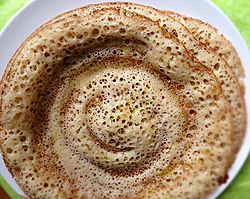Lahoh facts for kids
 |
|
| Alternative names | Lahuh, Laxoox, Canjeero, and Canjeelo |
|---|---|
| Type | Flatbreads/Pancake |
| Place of origin | Somalia |
| Region or state | Horn of Africa and Yemen |
| Main ingredients | Plain flour, Sorghum flour, Wheat flour, Self-rising flour, White cornmeal/cornflour, Water, Yeast, Salt |
| Variations | Cambaabur, Laxoox Abu-Beed |
Lahoh (pronounced la-HOOH) is a soft, spongy flatbread, a bit like a thick pancake. It first came from Somalia. This tasty bread is a popular food in countries like Somalia, Djibouti, Ethiopia, and Yemen.
You might hear Lahoh called by other names too. In Somaliland, Somalia, and Djibouti, it's often known as Laxoox or Canjeero. In Yemen, people usually call it Lahoh or Lahuh. It even became popular in Israel because of Jewish people who moved there from Yemen.
How Lahoh is Made
Lahoh is usually made from a thick mix called a batter. The main ingredients are sorghum flour, white cornmeal, warm water, yeast, and a little bit of salt. Many people prefer to use sorghum flour for the best Laxoox.
People mix the batter by hand until it is smooth and creamy. Then, they let it sit overnight. This allows the yeast to work, making the batter light and ready to cook for breakfast.
There are also different kinds of Lahoh. Some are sweet, and some are made with eggs. There is also a spiced version called Cambaabuur (or Ambaabuur). This spiced Lahoh is often eaten by Somali families for breakfast during Eid celebrations.
Traditionally, Lahoh is cooked on a special round metal stove called a taawa. If you don't have a taawa, you can also cook it in a regular pan.
Where Lahoh is Eaten
Lahoh is a very common breakfast food in Somalia, Djibouti, and parts of Ethiopia and Kenya. For breakfast, people often eat it with subag (a type of Somali butter or ghee), olive oil, sesame oil, or with sugar or honey. Sometimes, it's eaten with savory dishes like "beer" (liver and onions), "suqaar" (stir-fried meat), or "odkac/muqmad".
Sometimes, Lahoh is eaten for lunch. When it's eaten for lunch, it often goes with a Somali stew, soup, or curry. Almost always, Lahoh is enjoyed with a cup of Somali tea.
In Yemen, you can often buy Lahoh from street sellers. It is also found in Israel, where it was brought by Yemenite Jews who moved there.
See also
 In Spanish: Laḥoḥ para niños
In Spanish: Laḥoḥ para niños

